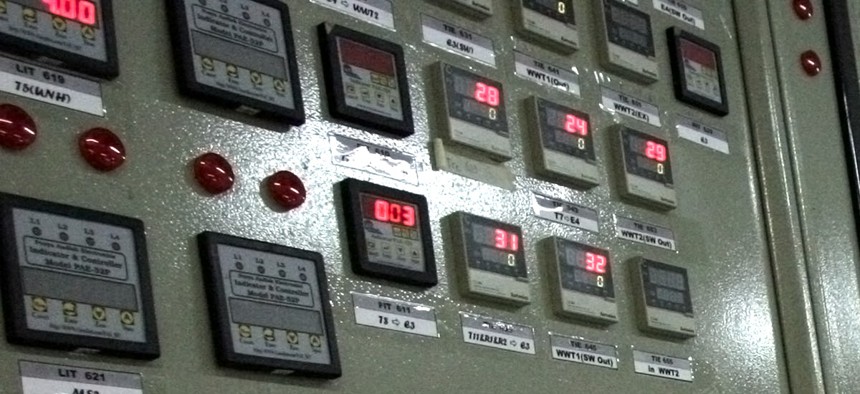
Vahid Salemi/AP
Iran's New Nuclear-Fuel Plan Spurs Uncertainty in the West
Iranian nuclear talks seemed promising, but leaked plans to make fuel raise red flags. By Diane Barnes
Atomic-energy plans unveiled this week by a top Iranian nuclear official could cast doubt on Tehran's readiness to negotiate limits on fuel-production technologies that also could generate bomb material, Western issue experts told Global Security Newswire.
The United States and five other countries have been expected to press Iran in ongoing talks to dismantle at least a portion of its uranium-enrichment centrifuges -- a move that could prevent the Middle Eastern country from rapidly making enough highly enriched fuel for a nuclear weapon, analysts said. Tehran has maintained for years that it only wants its nuclear equipment for nonmilitary use, but its assurances have so far failed to sway Washington and U.S. allies.
In recent days, the dynamics of these latest, behind-closed-doors talks on Iran's nuclear aspirations -- launched in Geneva on Oct. 15 by the seven nations' political directors, who plan to meet again on Nov. 7 -- may have changed. The stakes are high, as a collapse in negotiations could leave the sides with no clear route to resolve the standoff that some fear could escalate into war.
On Tuesday, Iran's atomic energy organization indicated the country might soon begin producing its own power-plant fuel. This move has prompted some analysts to question whether the country is willing to reduce its quantity of enrichment centrifuges, a move that could prove crucial to defusing the international standoff.
The six countries negotiating with Iran want to ensure that if the Middle Eastern country decided to use its centrifuges to produce nuclear-bomb material, other governments would have time to respond with military or other measures before Tehran could produce enough fuel for a weapon, a former Obama WMD czar and other experts have indicated.
This week's revelation that Iran could start making its own atomic fuel has "interesting" timing, because the nation's negotiators have insisted on the confidentiality of their discussions with the five permanent U.N. Security Council member nations and Germany, said Simon Henderson, director of the Gulf and Energy Policy Program at the Washington Institute for Near East Policy.
Iran plans in three months to start manufacturing "uranium dioxide" to "feed" its single nuclear power plant, a state media report quoted agency head Ali Akbar Salehi as saying.
The Iranian news article appears to refer to the production of uranium fuel rods, a process in which uranium dioxide is an "intermediate product," Henderson said in a brief telephone interview.
"The Russians would probably be very happy to continue supplying the fuel, but the Iranians are essentially signaling that [if] they want to fuel this reactor themselves, they need to retain a very large enrichment capacity," the analyst said.
He added it is impossible to know whether Salehi's announcement was a negotiation tactic coordinated with diplomats.
Iran would need between 60,000 and 100,000 of its most-basic centrifuge model -- more than three times the number it now possesses -- to fully take over fuel production for its nuclear plant at Bushehr, said David Albright, head of the Institute for Science and International Security in Washington.
That quantity might be enough to run the Bushehr reactor, but Salehi on Thursday reaffirmed plans to build more atomic energy sites that would require additional fuel.
Speaking to GSN by telephone, Albright said Iran would have to cap its enrichment program at no more than 10,000 "IR-1" machines to provide a six-month buffer period adequate for an international response if the nation tried to produce nuclear-weapon fuel.
Meeting that requirement would require Iran to dismantle some of its enrichment equipment already in place, according to International Atomic Energy Agency data highlighted in a Thursday analysis by Albright's organization.
As of August, Iran had more than 19,000 IR-1 centrifuges installed at its main enrichment plant and in a hardened bunker facility, according to the findings. Of those machines, 10,190 were actively enriching uranium.
Albright, though, cautioned against viewing Salehi's announcement in a strictly negative light.
"It cuts both ways," he said, because fuel rods are harder to convert into bomb fuel than their precursor material, low-enriched uranium hexafluoride. Iran has already amassed tens of thousands of pounds of the latter substance.
Former U.S. State Department official Mark Fitzpatrick said Iran's fuel-production announcement lines up with its previously stated proposal to produce power-reactor material from stockpiled uranium.
However, he added in an e-mail that the Middle Eastern nation might not be capable of generating material for use in its own power reactor.
"I doubt that Russia has provided the specifications that would allow Iran to safely use domestically produced fuel rods in the Bushehr reactor," said Fitzpatrick, who now heads the Nonproliferation and Disarmament Program at the London-based International Institute for Strategic Studies.
The nuclear plant was constructed by a Russian state-run contractor, which managed the site until last month.



